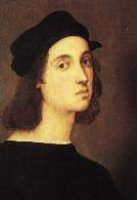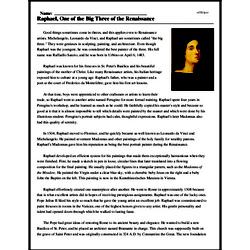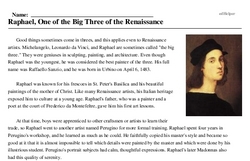Raphael, One of the Big Three of the Renaissance
Raffaello Sanzio
Reading Comprehension for April 6
Good things sometimes come in threes, and this applies even to Renaissance artists. Michelangelo, Leonardo da Vinci, and Raphael are sometimes called "the big three." They were geniuses in sculpting, painting, and architecture. Even though Raphael was the youngest, he was considered the best painter of the three. His full name was Raffaello Sanzio, and he was born in Urbino on April 6, 1483.
Raphael was known for his frescoes in St. Peter's Basilica and his beautiful paintings of the mother of Christ. Like many Renaissance artists, his Italian heritage exposed him to culture at a young age. Raphael's father, who was a painter and a poet at the court of Frederico da Montefeltre, gave him his first art lessons.
At that time, boys were apprenticed to other craftsmen or artists to learn their trade, so Raphael went to another artist named Perugino for more formal training. Raphael spent four years in Perugino's workshop, and he learned as much as he could. He faithfully copied his master's style and became so good at it that it is almost impossible to tell which details were painted by the master and which were done by his illustrious student. Perugino's portrait subjects had calm, thoughtful expressions. Raphael's later Madonnas also had this quality of serenity.
In 1504, Raphael moved to Florence, and he quickly became as well known as Leonardo da Vinci and Michelangelo. He painted seventeen Madonnas and other paintings of the holy family for wealthy patrons. Raphael's Madonnas gave him his reputation as being the best portrait painter during the Renaissance.
Raphael developed an efficient system for his paintings that made them exceptionally harmonious when they were finished. First, he made a sketch in pen in loose, circular lines that later translated into a flowing composition for the final painting. He usually placed the figures in a triangular pattern, such as the Madonna of the Meadow. He painted the Virgin under a clear blue sky, with a cherubic baby Jesus on the right and a baby John the Baptist on the left. This painting is now in the Kunsthistorisches Museum in Vienna.




